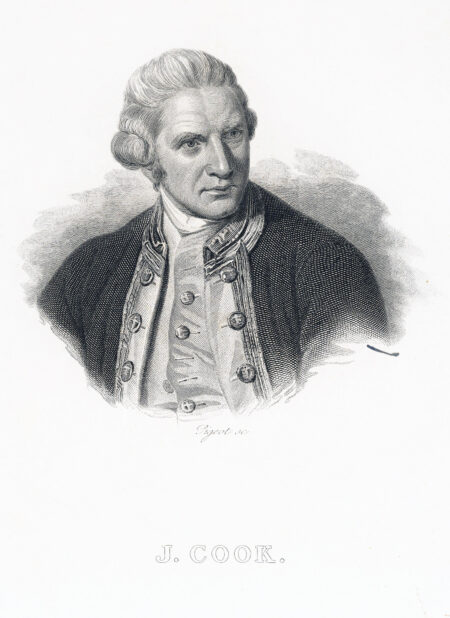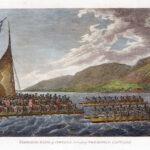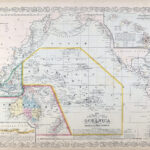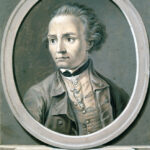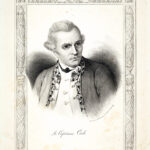James Cook
Explorer
Modern
Quick Facts:
British navigator and explorer who explored the Pacific Ocean and several islands in this region. He is credited as the first European to discover the Hawaiian Islands.
Introduction
Captain James Cook is known for his extensive voyages that took him throughout the Pacific. He mapped several island groups in the Pacific that had been previously discovered by other explorers. But he was the first European we know of to encounter the Hawaiian Islands. While on these voyages, Cook discovered that New Zealand was an island. He would go on to discover and chart coastlines from the Arctic to the Antarctic, east coast of Australia to the west coast of North America plus the hundreds of islands in between.
Biography
Early Life
James Cook was born on October 27, 1728 in the village Marton-in-Cleveland in Yorkshire, England. He was the second son of James Senior and Grace Cook. His father worked as a farm laborer. Young James attended school where he showed a gift for math.1 But despite having a decent education, James also wound up working as a farm laborer, like his father. At 16, Cook became an apprentice of William Sanderson, a shopkeeper in the small coastal town Staithes. James worked here for almost 2 years before leaving to seek other ventures. He then became a seaman apprentice for John Walker, a shipowner and mariner, in the port of Whitby. Here, Cook developed his navigational skills and continued his studies. Cook worked for Walker’s coal shipping business and worked his way up in rank. He completed his three-year apprenticeship in April 1750, then went on to volunteer for the Royal Navy. He would soon have the opportunity to explore and learn more about seafaring. He was assigned to serve on the HMS Eagle where he was quickly promoted to the position of captain’s mate due to his experience and skills. In 1757, he was transferred to the Pembroke and sent to Nova Scotia, Canada to fight in the Seven Years’ War.
Cook continued to expand his maritime knowledge and skills by learning chart-making. He helped to chart and survey the St. Lawrence River and surrounding areas while in Canada. His charts were published in England while he was abroad. After the war, between 1763 and 1767, Cook commanded the HMS Grenville, and mapped Newfoundland and Labrador’s coastlines. These maps were considered the most detailed and accurate maps of the area in the 18th century. After spending 4 years mapping coastlines in northeast North America, Cook was called back to London by the Royal Society. The Royal Society sent Cook to observe an event known as the transit of Venus. During a transit of Venus, Venus passes between the Earth and the Sun and appears to be a small black circle traveling in front of the Sun. By observing this event, they believed they could calculate the Earth’s distance from the Sun. In May 1768, Cook was chosen by the Society and promoted to lieutenant to lead an expedition to Tahiti, then known as King George’s Island, to observe the transit of Venus.2 This begin the first of several voyages that would earn James Cook great fame and recognition.
Voyages
Principal Voyage
James Cook sailed from Deptford, England on July 30, 1768 on his ship Endeavour with a crew of 84 men.3 The crew included several scientists and artists to record their observations and discoveries during the journey. They made many small stops at different locations along the way. In January 1769, they rounded the tip of South America, and finally reached Tahiti in April 1769. They established a base for their research that they named Fort Venus. On June 3, 1769, Cook and his men successfully observed the transit of Venus. While on the island, they collected samples of the native plants and animals. They also interacted with some native people, learning more about their customs and traditions. Cook sailed to some of the neighboring islands, including modern day Bora Bora, mapping along the way. After completing the observation of Venus’ transit, Cook was given new orders to sail south, search for the Southern Continent – known today as Australia. On August 9, 1769, the Endeavour departed from Tahiti in search of the Southern Continent. After sailing for several weeks with no sign of land, Cook decided to sail west. On October 6th, land was sighted, and Cook and his men made landfall in modern day New Zealand.
Cook named the place Poverty Bay. They were met by unfriendly natives, so Cook decided to sail south along the coast of this new land. He named several islands and bays along the way, such as Bare Island and Cape Turnagain. At Cape Turnagain, the Endeavour turned around and sailed north along the coastline again and rounded the northernmost tip of the island. They sailed down along the western coast Cook and his men crossed a strait to return to Cape Turnagain, thus completing a circumnavigation of the northern island. This trip proved that New Zealand was made up of two separate islands. The expedition then sailed south along the eastern coastline of the southern island. They stopped at Admiralty Bay on the northern coast to resupply before sailing west into open ocean. In April of 1770, Cook first spotted the northeastern coastline of modern day Australia. He landed in Botany Bay near modern day Sydney.4 He explored some of the area and coastline including places such as Port Jackson and Cape Byron. The Endeavour then sailed around the northernmost tip of the continent before setting sail east back to England. They soon landed in Batavia, now known as Jakarta, in Indonesia. In Batavia, several of the crew, including James Cook became ill, many dying from diseases.5 The expedition eventually sailed onward, and reached London on July 13, 1771.
Subsequent Voyages
In 1772, Cook was promoted to captain. He was given command of the two ships, the Resolution and Adventure, to look for the Southern Continent. On July 13, 1772, the expedition left England, stopping at the Cape of Good Hope to resupply before sailing south. May 26, 1773, Cook and his crew reached Dusky Bay, New Zealand . They spent the winter anchored in Ship Cove, exploring inland and interacting with the Maori natives. When they departed from New Zealand in October of 1773, the two ships became separated and never reunited.6 The Adventure returned to England. Cook and the Resolution continued onward exploring various islands throughout the Pacific. While sailing in the Pacific, the Resolution crossed into the Antarctic Circle several times sailing farther south than any other explorer at the time. Several times they got stuck in sea ice. So Cook decided to suspend the search for the Southern Continent. But they did not return to England just yet. They sailed to Easter Island and stayed there for seven months, exploring and mapping the nearby Society Islands and the Friendly Islands. November 10, 1774, the Resolution began its return journey to England.They traveled around the tip of South America and stopped briefly on the Sandwich Islands to claim them for England. Cook finally returned to England on July 30, 1775 and reported that there was no Southern Continent to be found.
Just one year later, Cook was given the Resolution and Discovery to lead yet an expedition to search for the Northwest Passage. The ships left England on July 12, 1776. A storm forced them to stop at Adventure Cove in Tasmania before continuing on to Ship Cove. In December of 1777 the men landed at Christmas Island, now known as Kiritimati. Several weeks later, they made a significant discovery when they came upon the islands of Hawaii. They landed at modern day Kauai and were fascinated by the environment and friendly natives. But Cook still wanted to discover the Northwest Passage so they left two weeks laters. They finally landed at modern day Vancouver Island where they interacted and traded with the native people. Cook continued his search for the Northwest Passage and commanded the expedition to sail northwest along the coastline of what is now Alaska, and throughout Prince William Sound. On August 9th, they reached the westernmost point of Alaska, which Cook named Cape Prince of Wales. From here, Cook sailed farther into the Arctic Circle until he was stopped by a thick wall of ice. Cook named this point Icy Cape. Cook and his men sailed back down the coast of Alaska and back south until they reached the Hawaiian Islands again.
Later Years and Death
When first landing in Kealakekua Bay, they were met with angry natives. Cook soon met with the Hawaiian ruler, King Kalei’opu’u. It was a friendly meeting, was given large amounts of food and resources.They left Kealakekua Bay on February 4, 1779 but were forced to return a few days later after the Resolution was damaged in a storm. Once more, they were not greeted with joy by the natives. While the Resolution was being repaired, the crew noticed that the natives were stealing their supplies and tools. On February 14th, Cook attempted to stop the thievery by taking Chief Kalei’opu’u hostage.7 However, fighting between the crew and native people had already started. When Cook attempted to return to his ship, he was attacked on the shoreline. He was beaten with stones and clubs and stabbed in the back of the neck. Cook died on the shore and his body was left behind as the other men returned to the ship. After making peace with the natives a few days later, pieces of Cook’s body were recovered and buried on February 22, 1779. The next day, the remaining crew left Hawaii to return to England. The ships arrived in England on October 4, 1780 after attempting to search for the Northwest Passage one more time.
Legacy
Captain James Cook is known for his incredible voyages that took him farther south than any other explorer of his time. He was not able to prove that a southern continent existed, but he had many other achievements. He was the first to map the coastlines of New Zealand, the eastern coastline of what would become Australia, and several small islands in the Pacific. Cook was also one of the first Europeans to encounter the Hawaiian Islands. His reports on Botany Bay were part of the reason Britain established a penal colony there in 1787.8 He is still recognized today for creating some of the most accurate maps of the Pacific islands during his time. James Cook helped the south seas go from being a vast and dangerous unknown area to a charted and inviting ocean.
EndnotesImages

